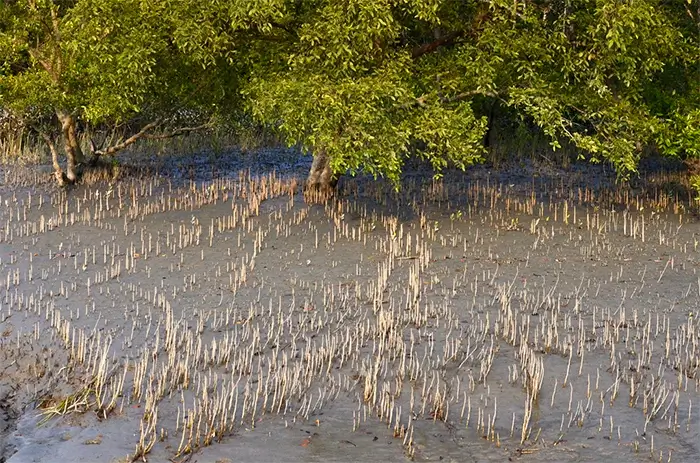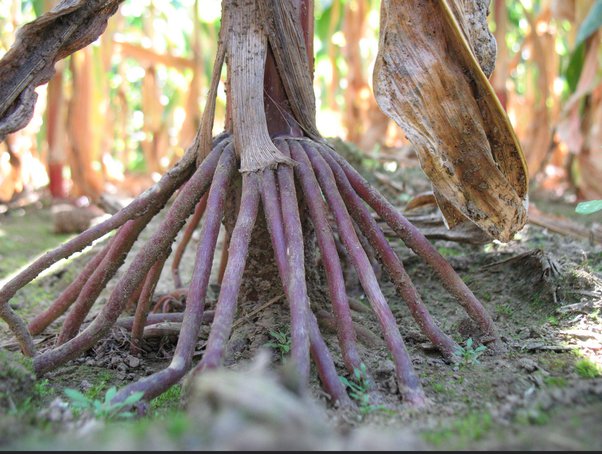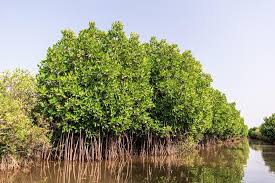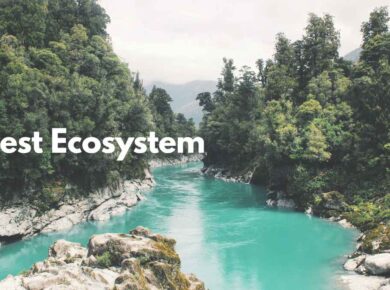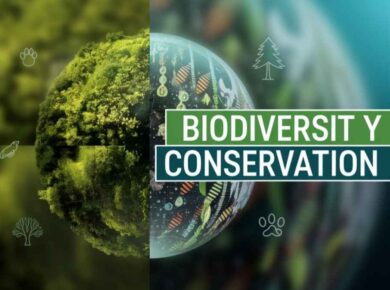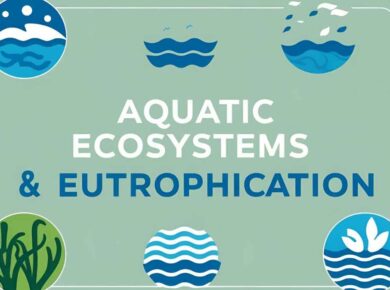Mangroves and Coral Reefs
Mangroves
Mangroves are the trees & bushes growing below the high-water level of spring tides, which exhibits remarkable capacity for saltwater tolerance. Basically, Littoral evergreen land plants growing on sheltered shores typically on tidal flats, deltas, estuaries, bays etc. where abundant silt is brought down by rivers.
- Exhibits viviparity mode of reproduction e. seeds germinate in the trees itself, before falling to ground (An adaptive mechanism to overcome problem of germination in saline water)
- Produces pneumatophores (Blind or arial roots) to overcome respiration problem in anaerobic soil conditions as these aerial roots enable plants to breathe air through waterlogged soil
- Some Mangroves secrete excess salt through their leaves (form crystals of salt on back of leaves) & some block absorption of salt at their roots
- Produce stilt/Prop roots, which emerged from main trunk of the tree above ground level i.e. aerial pitchfork-like extensions from the trunk which grow downwards and anchor themselves in the soil trapping sediment which helps to stabilize the tree, subjected to tides and flooding
Mangroves of sundarban are the largest single block of tidal halophytic mangroves of the world, famous for Bengal tigers & crocodiles.
Mangrove Profile in India
| Sundarban | Gujrat | Goa & Ratnagiri | |
| Mahandi, Krishna-Godavari, Cauvery | Andaman & Nicobar | ||
Coral Reefs
- underwater structures made from calcium carbonate secreted by corals
- colonies of tiny living animals like calcareous algae, gastropods, green algae, sino bacteria, oyester, mollusca etc found in marine waters
- often called “rainforests of the sea” as they form some of the most diverse ecosystems on Earth
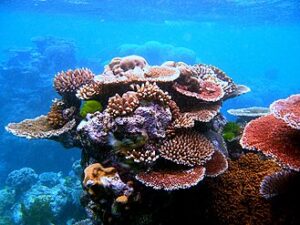
- An individual coral is known as a polyp which ingests tiny organisms called plankton & other small creatures. Thousands of identical polyps live together and form a coral colony.
- Each polyp excretes a calcium carbonate exoskeleton beneath it and, over long periods of time, the skeletons of many coral colonies add up to build the structure of a coral reef.
- Many other species – fish, invertebrates, algae and microorganisms – make their homes on and around this reef.
Prominent Features of Coral Reefs
- Coral lives a symbiotic life. Inside the sac of each coral polyp lives one-celled algae called zooxanthellae.
- Algae gives off oxygen and other nutrients that the coral polyp needs to live and in return the polyp gives the algae carbon dioxide and other substances the algae needs.
- That is why coral reefs grow so near the surface of the water where it is the sunniest–the algae need sunshine for photosynthesis.
- Despite occupying less than 1% of the world’s ocean surface, they provide a home for 25% of all marine species
- In addition to providing corals with essential nutrients, zooxanthellae are responsible for the unique and beautiful colors of many stony corals
Coral Bleaching
- When water temperatures increase, the polyps expel their algal cells (zooxanthellae )and the colony takes on a stark white appearance; commonly described as “coral bleaching
- If the polyps go for too long without zooxanthellae, coral bleaching can result in the coral’s death.
Causes of Coral Bleaching
- Global Warming (Rise of Water Temperature)
- Diseases: Coral Plague + Black Band Disease + White Band Disease
- Marine Pollution + Acidification + Oil Leakage
- Frequent formation of El Nino
- oxygen starvation
- increased sedimentation
- changes insalinity
Types of Coral Reefs
Coral reefs begin to form when free-swimming coral larvae attach to submerged rocks or other hard surfaces along the edges of islands or continents. As the corals grow and expand, reefs take on one of three major characteristic structures – fringing, barrier or atoll.
Fringing reefs
- Most common type
- Project seaward directly from the shore
- Forming borders along the shoreline and surrounding islands
Barrier reefs
- Grow at border shorelines, but at a greater distance.
- They are separated from their adjacent land mass by a lagoon of open, often deep water.
Atoll
- Usually circular or oval, with a central lagoon
- If a fringing reef forms around a volcanic island that subsides completely below sea level while the coral continues to grow upward, an atoll forms.
- Parts of the reef platform may emerge as one or more islands, and gaps in the reef provide access to the central lagoon
Conditions required for coral reef formation
- Clear tropical ocean water usually between 30N to 30S latitudes
- water temperature must be between 20-25* C
- can form to depth of 90 meters since at this depth algae can form food through photosynthesis
- not found near mouth of river where lots of sediments are unloaded into ocean.
- formed only in saline water with almost 27 PPT
Coral Profile India
| Lakshadweep | Malvan Goa | Gulf of Kutch | |
| Palk bay to Gulf of Mannar | Andaman & Nicobar | ||

